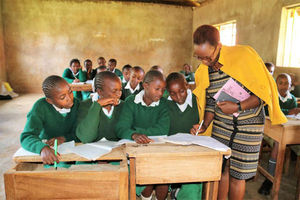
Former President Uhuru Kenyatta during a past address to the nation.
Uhuru Kenyatta's entry into parliament and cabinet was the triumphant culmination of an inexorable sequence of assiduously calibrated, politically consequential manoeuvres.
This entailed the inspired mobilisation of all the formidable apparatus of a monolithic party towards the singular end of propelling the incumbent president's favoured apprentice along a trajectory to the very apex of politics and government that was as spectacular as it was unprecedented.
The entire scheme of action persists as a paradox of possibility, in the sense that it almost worked, and almost failed. This is to say that the best-laid plans of Nyayo and Kanu did go awry, reassigning the herculean potency of the titanic personages involved, to move Kenya's political earth and heaven, just to deliver a more less satisfactory substitute in place of their first aspiration.
Kenyatta's pupilage had begun in earnest with a couple of appointments to parastatal board chairmanships, followed by elective Kanu branch chairmanship. The languid momentum of this progress struck an inflection in 1997 when Kenyatta was encouraged to contest the Gatundu South parliamentary seat on a Kanu ticket. Matters were then such that different facets of Kenyatta's pedigree converged to make him the candidate to beat in that election.
A couple of days before the election or thereabouts, his rival, hitherto an unfavoured chancer as obscure then as he remains now, ‘disappeared'. On the eve of the election, his car was located at the bloodied banks of a ravine, but the opposition candidate remained unaccounted for.
It was enough to ruin Kenyatta's maiden innings, because context did the rest: an opposition candidate had disappeared, and Gatundu grappled with unsettling clues pointing at a possibly violent end. Kanu was political anathema in the region; only six years earlier, a serving minister had disappeared before his remains were found in the wild. Kenyatta, the prince of the political establishment, was also the scion of his larger-than-life namesake, Jomo, who enjoyed a solid reputation for predacious ruthlessness in his time.
Kanu grandee
In other words, the public was sedulously primed to alight on a single inference which cast young Kenyatta in an extremely unbearable light. The candidate did materialise on the day of voting, but by then, no one wanted anything to do with Kanu or Kenyatta, who duly lost.
This left Nyayo with no choice but to move earth and heaven once more, first, by decapitating a Kanu grandee to make way for Kenyatta in parliament, which was sine qua non for entry into the cabinet, whereupon Kenyatta was appointed Minister for Local Government. A few years later, he would be a national vice-chairman of the independence party, which nominated him to contest the presidency of the Republic in the 2007 election.
It is generally acknowledged that Kenyatta's baptism of fire marked the advent of sophisticated fake news strategies in political campaigns. Ancient playbooks mainly relied on the abduction of candidates to disqualify them because nomination documentation had to be submitted in person. Alternatively, copies of ‘leaflets’ announcing a rival candidate's withdrawal from a contest would be circulated at night, leaving them to divert their strategic resources into denials and clarifications that, in any event, would scarcely avail. Female candidates were shamed with ersatz news reports implicating them in salacious escapades with shady characters.
The unwholesome enterprise which left Kenyatta in a sticky wicket may have been brazen and avant-garde enough to worry concerned minds about the implications for democratic discourse of engagements driven by, or substantially premised upon deception.
Candidates who prevail by liberally deploying fabrications - by exploiting illusions to mobilise intense euphoria in their favour, while concocting fabulous chicanery to incite vehement disenchantment of their rivals - acquire authority by false pretences and utilise the form and letter of the democratic framework whilst undermining its substance and irrevocably polluting its spirit.
Holographic projection
To underscore how far in time 1997 is, consider the following. A decade ago, India's prime minister boldly dispatched a realistic holographic projection to address several rallies in far-flung locations on the world's vastest democracy, thereby affirming an aspirational profile of a rampant India dominating the global technology industry.
But what else can a holographic projection accomplish? Early this year, fraudsters using deepfake technology deceived an officer at a large financial corporation in Hong Kong to pay them over Sh3 billion, believing that the payment had been authorised during a video call ostensibly attended by his colleagues, including the chief financial officer. In fact, every participant in the call, except the hapless officer, was a deepfake recreation.
How long will it be before fake news conferences take place with deepfakes or unauthorised holographic projections of real persons from conferring or receiving degrees, wedding, dying, resigning, withdrawing their candidatures or conceding defeat?
What will be our criteria for belief? How much truth in the digital age will remain factual, and how much digitisation will serve the ends of clarifying reality and not sabotaging or substituting it, or bewildering our perceptions until anything goes? All told, Kenyatta is extremely fortunate that 1997 is not 2024.










